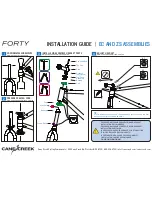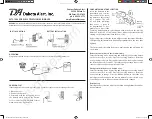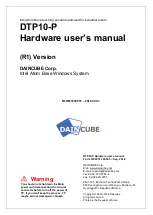
3
Digital Temperature Interlock
Resistive Temperature Detector(s)
Duct Collar Mounting
1. Locate the exhaust duct on top of the hood. A 3/4 to
7/8-inch
(19.0 to 22.2 mm)
diameter hole must be cut
into the duct 2 inches
(50.8 mm)
above the
hood top. Center the
hole along the side
of the duct. Make
sure that the resistive
temperature detector
will not interfere with
any fire system nozzles, or other items installed in
the exhaust duct. If an exhaust fire damper is present
the hood exhaust collar, it must be removed prior to
temperature sensor installation.
2. Place the J-box plate inside of the octagon extension
ring and place over the hole in the exhaust collar.
3. Disassemble the
compression
seal and place
through hole in
duct collar and
J-box plate as
shown. Tighten
the nut inside
the octagon
extension ring.
4. Place the
resistive
temperature
detector
through the
compression
seal and
tighten the
compression
fitting.
5. Refer to Electrical Connections section for
instructions on wiring the temperature sensor.
6. Install the cover for the octagon box.
NOTE
All field installation and wiring of electrical equipment
must be done to meet NEC and local codes.
5. Place the resistive
temperature
detector through
the compression
seal and tighten
the compression
fitting.
6. Refer to Electrical
Connections
section for
instructions on wiring the temperature sensor.
7. Install the cover for the octagon box.
Resistive Temperature
Detector (RTD)
PN 384925
Octagon Cover
PN 380926
Octagon Extension
PN 830125
2 inches
(50.8 mm)
Hood Exhaust Collar
Front Side
0.75 to 0.875 inch
(19.0 to 22.2 mm)
diameter hole
Octagon Extension
PN 830125
Lock Washer
Nut
1/4-inch Compression Seal
PN 463570
J-Box Plate
PN 732396
Quik Seal
Gasket
Resistive Thermostat
Detector (RTD)
PN 384925
Octagon Cover
PN 380926
Octagon Extension
PN 830125
Electrical Connections
Sensor Connections
1. Run two 18 awg stranded thermostat wires from
each temperature sensor to the appropriate electrical
circuit connections. (See Step 3 for connection
options).
2. In junction box, connect leads on RTD to the 18 awg
conductors using appropriate size wire nuts.
• Wires are interchangeable with one another.
3.
Choose
the final
connection
option
based on:
CAUTION
Do not connect temperature sensor in series with fan
power. This will result in damage to the temperature
sensor and will require replacement.
NOTE
Separate as much as possible the probe and digital
input cables from inductive loads and power cables,
to avoid any electromagnetic disturbance. Never lay
power and probe cables in the same cable conduits
(including those for the electrical panel). Loosen
every screw and insert the cable end, next tighten
the screws and gently pull the cables to check their
tightness.
Switch Connections to Control Box or
Fan Control Center
Connect a Single Pole Single Throw (SPST) switch
to terminals S1H and S1. This is the same whether
temperature interlock is in a separate control box or
integrated in a kitchen fan control center.
Circuit Connections
1. Standard Interlock Control
•
120VAC, 10 or 15 amp circuit to terminals
H1 and N1
•
120VAC, 24VAC or other control circuit for fan
starter activation (factory separated from main
power connection shown in previous bullet)
- Control circuit power to terminal CP1
- Terminal CP2 to fan starter coils (hot)
2. Kitchen Fan Control Center Integration (KFCC)
•
120VAC, 15 amp circuit to H1 and N1 in fan
control center
- No additional control circuits are required
- Fan starters are factory-wired.
Sensor
Terminals
First Sensor
T1-A and T1-B
Others
(if applicable)
T2-A and T2-B
T3-A and T3-B
T4-A and T4-B
T5-A and T5-B
T6-A and T6-B
T7-A and T7-B
T8-A and T8-B
T9-A and T9-B
T10-A and T10-B
T11-A and T11-B
T12-A and T12-B
®


























